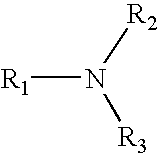Enzymatic production of glycolic acid
a technology of glycolic acid and enzyme, which is applied in the field of microorganisms and molecular biology, can solve the problems of enzyme inactivation within a short period of time, insufficient production of -hydroxy acids from corresponding -hydroxy nitrites, and inability to meet commercial needs, etc., to facilitate recombinant expression and facilitate recombinant expression
- Summary
- Abstract
- Description
- Claims
- Application Information
AI Technical Summary
Benefits of technology
Problems solved by technology
Method used
Image
Examples
example 1
Construction of High Copy Nitrilase Expression Plasmid
[0215]Synthetic Oligonucleotide Primers
[0216]
165(5′-CGACTGCAGTAAGGAGGAATAGGACATGGTTTCGTATAACAGCAAGTTC-3′; SEQ ID NO:1)and166(5′-TGATCTAGAGCTTGGAGAATAAAGGGGAAGACCAGAGATG-3′; SEQ ID NO:2)
(which incorporate Pstl and Xbal restriction sites (underlined), respectively) were used to PCR amplify the nitrilase gene from A. facilis 72W (ATCC 55746) genomic DNA (SEQ ID NO:5).
Typical PCR parameters are as follows:[0217]Step 1: 5 minutes at 95° C.[0218]Step 2: 0.5 minute at 95° C. (denaturation)[0219]Step 3: 0.5 minute at 55° C. (annealing)[0220]Step 4: 1 minute at 74° C. (extension)[0221]Steps 2–4 are repeated 25 cycles
PCR reagents are supplied by and used as recommended by Roche Diagnostics Corporation (Indianapolis, Ind.).
[0222]The only change from native Acidovorax facilis 72W sequence is a change to the first nucleotide from G to A to facilitate expression in E. coli. In so doing, the start codon of the nitrilase gene was changed from th...
example 2
Expression of Active Nitrilase in E. coli
[0223]Plasmid pSW138 was used to transform E. coli MG1655 (ATCC 47076) and E. coli FM5 (ATCC 53911) to generate the two strains identified as (1) MG1655 / pSW138 and (2) FM5 / pSW138, respectively. Each strain was grown, induced, harvested, and assayed for nitrilase activity (conversion of glycolonitrile to glycolic acid) as described below. Replicates of six are performed for each strain.
[0224]Strain inoculums were grown in LB media supplemented with ampicillin (50 mg / L), at 37° C. with shaking (200 rpm) for 16–18 hours.
2. Induction of Nitrilase Expression
[0225]Sufficient inoculum was added to fresh LB media supplemented with ampicillin (50 mg / L) and IPTG (1 mM) to give an initial OD (600 nm) of approximately 0.1. Cultures were incubated at 37° C. with shaking (200 rpm) for approximately 6–8 hours.
3. Bacterial Harvest
[0226]Bacterial cells were harvested by centrifugation, removing as much liquid as possible, and cell pellets ...
example 3
Construction of A. facilis 72W Nitrilase Random Mutagenesis Libraries by Error-Prone Polymerase Chain Reaction
[0229]Genomic DNA was prepared from A. facilis 72W (ATCC 55746) using a Puregene® DNA isolation kit according to the manufacturer's instructions (Gentra Systems, Minneapolis, Minn.). Error-prone PCR was performed on the A. facilis 72W nitrilase gene (coding sequence; SEQ ID NO:5) using primers identified as SEQ ID NO: 3 (5′-GCGCATATG GTTTCGTATAACAGCAAGTTCC-3′) and SEQ ID NO: 4 (5′-ATAGGATCCTTATGGCTACTTTGCTGGGACCG-3′) according to instructions supplied with the GeneMorph® PCR Mutagenesis Kit (Stratagene, La Jolla, Calif.). Reaction conditions recommended to produce a low mutation frequency (0–3 mutations / kb) and a medium mutation frequency (3–7 mutations / kb) were employed. Ten percent of the 1.1 kb PCR product was ligated into the expression vector pTrcHis2 TOPO® according to instructions supplied with the pTrcHis2 TOPO® TA Expression kit (Invitrogen, Carlsbad, Calif.). One h...
PUM
| Property | Measurement | Unit |
|---|---|---|
| weight | aaaaa | aaaaa |
| weight | aaaaa | aaaaa |
| weight | aaaaa | aaaaa |
Abstract
Description
Claims
Application Information
 Login to View More
Login to View More - R&D
- Intellectual Property
- Life Sciences
- Materials
- Tech Scout
- Unparalleled Data Quality
- Higher Quality Content
- 60% Fewer Hallucinations
Browse by: Latest US Patents, China's latest patents, Technical Efficacy Thesaurus, Application Domain, Technology Topic, Popular Technical Reports.
© 2025 PatSnap. All rights reserved.Legal|Privacy policy|Modern Slavery Act Transparency Statement|Sitemap|About US| Contact US: help@patsnap.com


